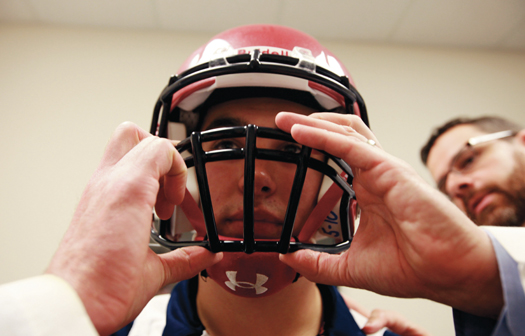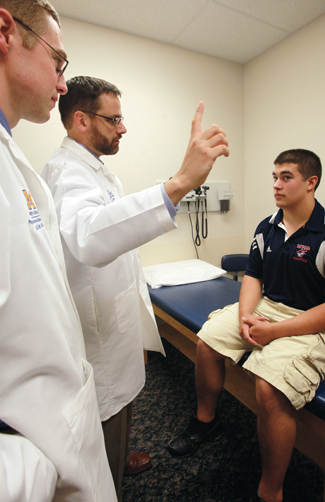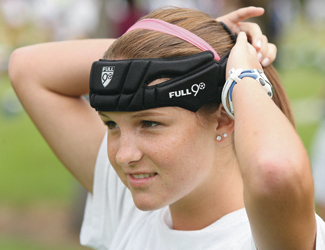
Spencer Helgren, 16, (pictured above and below) a high school football player from Westwood High School in the Upper Peninsula, Mich., suffered a concussion playing football. Here, he puts on his new helmet for physicians Jeff Kutcher and J.T. Eckner (right), to see how it fits at Michigan Neurosport in Ann Arbor.
More than 3 million U.S. children and teens participate in organized youth football programs — and another 3 million in US Youth Soccer, the nation’s largest youth sports organization. Last year alone, nearly 300,000 youths, ages 5 to 15, participated in Pop Warner play, the nation’s largest youth football program.
Recent data linking football with heightened concussion risks have generated much debate about the overall safety of youth football, with more than 40 states officially passing legislation outlining mandated concussion safety procedures for young players since 2009.
And concussion concerns for kids aren’t just relegated to football, as studies have also drawn links between head injuries and soccer, too, with some studies revealing more incoming college soccer players had experienced concussions in high school or earlier than incoming college football players.
While football-related injuries are responsible for roughly one out of every two youth-sport concussions in the U.S., injuries stemming from girls’ soccer represent the second most frequent cause of youth-sport concussions, according to a 2012 Nationwide Children’s Hospital report. Furthermore, an 11-year study of high school sport injury rates, published in the American Journal of Sports Medicine in 2011, revealed that among coed sports such as basketball and soccer, the concussion rate for girls was nearly twice the rate for boys playing the same sports. Bottom line: kids who play sports or who play in rec programs can get hurt, and youth agencies need to know how to help prevent such injuries. Reviewing these popular sports programs’ protocols can help.
“We’re Making Changes”
“We’re on the cutting board right now,” said Chris Prawdzik, president of the North Shore Youth Football Club, a Chicago-area program.
“Youth football…is being looked at really closely,” he continued. “There’s a lot of things that could be changed to make it a safer sport, but, at the end of the day, we all know that injuries happen, and we have to prepare ourselves the best we can to play the sport we all love.”
A former high school and college football player, Prawdzik has instructed children in programs in Minnesota and Illinois for the last seven years.
Recently, Prawdzik’s league partnered with USA Football, an Indianapolis-based nonprofit with endowments from the National Football League to attend classes about the latest on-field safety measures and practice techniques. The representatives from Prawdzik’s league then bring home their lessons to instruct other coaching personnel on the new policies and approaches.

Prawdzik said his league also requires players to take computerized exams measuring cognitive abilities before they are allowed on the field.
“It gives you a baseline test,” he said. “So if there is some type of trauma, or head injury of some sort, then they go in and take the test again, and now they have a baseline to compare what might have happened.”
The tests, he said, are offered free of charge to families in the program.
While a majority of states have passed legislation outlining youth football concussion protocols, there are no federal standards in place governing safety procedures. In states like Illinois — which currently does not have legislation in place laying out concussion policies for youth football programs — managers and directors are beholden to either organizational guidelines or, if applicable, standards outlined by city ordinances.
Prawdzik said, in terms of concussion policies, his league prefers to be proactive instead of reactive.
“We’re not waiting for decisions on the governmental level to be made,” Prawdzik added. “We’re making changes that are self-regulated to improve the health and safety of our kids and our families.”
Practice Makes Perfect?
Earlier this year, University of Pittsburgh researcher Dr. Michael Collins released findings from the first ever large-scale study of concussions in youth football.
Collins said that, given public concerns about player safety, he is surprised by the lack of research on the incident rates of concussions in youth football programs. “There’s been a lot of policy, a lot of concern, a lot of discussion, a lot of folks saying ‘we should do this’ with that population,” he said, “without actually having any kind of scientific data to guide the process.”
The study involved almost 500 youth football participants, ages 8 to 12. “We had people trained in concussion management observing the practice and observing the actual incidents of injury,” Collins said. “All these kids underwent baseline testing, so they were educated on what signs and symptoms to look for.”
According to Collins’ findings, the odds of a child suffering a concussion during a game was much higher than the rates of injury during practices.
“The actual true incident rate was a little lower than what we see at the high school level,” Collins said. While the rate of injury in high school football ranges from 50 to 10 percent, the results from Collins’ youth football assessment uncovered an injury rate resting at about 4 percent.
Collins said one of the best ways to mitigate concussions among young athletes is to implement better practice protocols. “The worst cases I see all year are on August 15 in my clinic, with kids that are going out for football for the first time [who] aren’t aware of how to properly play the game,” he said. Teaching kids the right strategies in drills might be a viable way to reduce injuries during play, Collins stated.
“We’re not advocating for kids to get out and hit their heads every practice,” he said. “[But] if we’re telling kids to limit practice, and they’re not learning the proper techniques and there is no standardized approach in how to teach kids proper technique…we can see negative outcomes from that.”
Technique, Technique, Technique

“There are a lot of different ways that we’re teaching techniques, but more importantly, the days of running full steam ahead, 20 yards away from one another and hitting each other are long gone,” Prawdzik said. “That does happen sometimes in the game of football, but as far as everyday practice and everyday contact, our contact between two players is no more than a couple of yards from one another.”
In his league, Prawdzik said helmet-to-helmet contact is forbidden, and children are instructed from “day one” to keep their heads up at all times during play.
“We spend weeks at the beginning of our season without shoulder pads on, teaching them technique,” he said. “Just walking them through, not full speed, technique, technique, technique. So that when we do get our full pads on and we start to hit, these techniques come natural to them.”
Instruction of the like, Prawdzik said, cannot be taught by fathers or high school athletes without extensive coaching themselves. “These are things taught by professionals who have experience and have gone through special training,” he said. “We require all our coaches to go through a certification of concussion awareness testing and recognition.”
To coach in his league, individuals also have to be certified and trained properly in various USA Football procedures before they can instruct youngsters. Certification standards for most community-based programs in the Chicago area, he said, are much more lax.
“We love the game of football, so we understand it’s an aggressive sport and people can get hurt playing it,” Prawdzik concluded. “What we’re doing is best preparing our families and kids for not having an injury, and that’s teaching the proper way to hit and the proper way to get hit.”
A Lack of Research
“In the short term, we’re very well aware that concussions can cause detrimental effects in kids,” Collins said. “In terms of the long-term effects, there is much less known.”
Simply put, he said there just is not enough data on concussions among young athletes to draw any conclusive findings.
“There hasn’t been a long-term, prospective study following a large cohort of kids over the course of 10, 20, 30 years,” he said. “There’s no science at all, in any way, shape or form, that’s been done to show what the true effects of concussions are in terms of long-term functioning.”
Collins’ clinic has published more than 100 peer-reviewed papers on concussions since the 1990s. Lost in media discussions about youth football safety, he said, is a general lack of knowledge about the longitudinal impact of concussions, especially among younger athletes.
“The reality is, there isn’t a study that has followed a cohort of kids over time to prove that concussions, in and of itself, can be the only factor that produces some of the pathology that’s being found out there in brains,” he said. “To a reasonable degree of scientific certainty, we don’t know whether the concussions are the isolative factor in causing that dysfunction.”
While Collins said reported injuries among high school players have increased over the last decade, he is not sure whether the uptick in concussions among teens can be attributed to an actual increase in injury rates or simply better recognition and awareness of concussion symptoms on the part of coaches and parents.
Regarding youth sport safety, Collins said education on concussions is pivotal for parents and program managers (see sidebar on Page 18). The best safeguards, he said, are to manage injuries properly and make sure young players with concussion symptoms receive effective treatment.
“If you have a concussion and you try to play through it, bad things can happen,” he concluded. “Everybody would agree with that point.”
Photo credits: Photos 1 and 2 by Regina H. Boone/Detroit Free Press/MCT, Photo 3 by Stephen M. Dowell Orlando Sentinel/MCT
Photo Caption: Lia Whitmore has sustained several concussions in her career playing soccer, so she now wears a head brace for protection. She is shown adjusting her brace (top) during practice in Orlando, Fla.





























